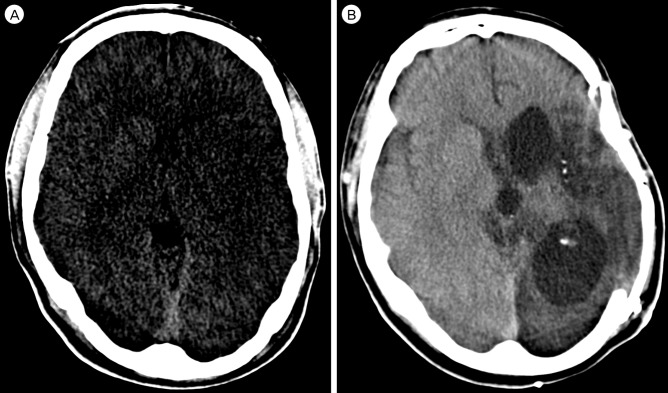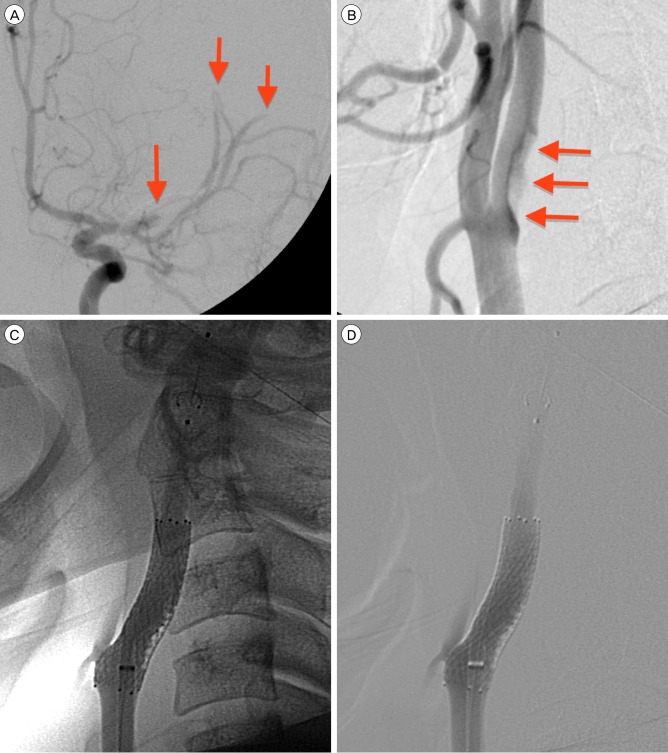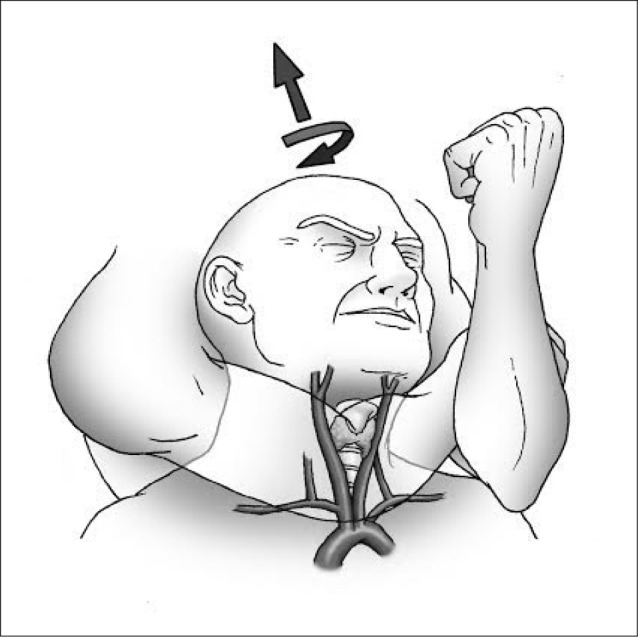J Cerebrovasc Endovasc Neurosurg.
2017 Jun;19(2):111-116. 10.7461/jcen.2017.19.2.111.
Internal Carotid Artery Dissection in Brazilian Jiu-Jitsu
- Affiliations
-
- 1Department of Neurosurgery, Ponthific Catholic University of Paraná - PUCPR - Curitiba (PR), Brazil. demartiniz@gmail.com
- KMID: 2393389
- DOI: http://doi.org/10.7461/jcen.2017.19.2.111
Abstract
- Carotid artery dissection is a significant cause of stroke in young patients. It may be asymptomatic and go undiagnosed, or minimal transient manifestations may follow, commanding a higher index of suspicion than ordinarily exists to avoid misdiagnosis. Reported herein is a 27-year-old man who suffered extracranial internal carotid artery dissection while practicing a Brazilian Jiu-Jitsu submission maneuver. The patient's condition suddenly deteriorated one week later due to distal embolization and stroke. Despite endovascular treatment, with stenting of the cervical carotid artery, neurologic deficits remained. Of note, the objective in martial arts, which is to kill or incapacitate, has yet to be fully tempered in transitioning to sport. Brazilian Jiu-jitsu, a relatively new and fast-growing form of martial art, places emphasis on submission maneuvers. Related injuries are not common knowledge and are poorly described in the literature. This account is intended to shed light on the risk of this discipline. Through education and improved supervision, vascular injuries of this nature and the potentially lethal or disabling consequences may thus be prevented in young athletes.
Keyword
MeSH Terms
Figure
Reference
-
1. Biondi A, Katz JM, Vallabh J, Segal AZ, Gobin YP. Progressive symptomatic carotid dissection treated with multiple stents. Stroke. 2005; 9. 36(9):e80–e82. PMID: 16100028.
Article2. Blunt SB, Galton C. Cervical carotid or vertebral artery dissection. BMJ. 1997; 1. 314(7076):243. PMID: 9022478.
Article3. Bogousslavsky J, Pierre P. Ischemic stroke in patients under age 45. Neurol Clin. 1992; 2. 10(1):113–124. PMID: 1556998.
Article4. Gupta V, Dhawan N, Bahl J. Minor trauma causing stroke in a young athlete. Case Rep Neurol Med. 2015; 3. 2015:182875. PMID: 25883815.
Article5. Hauser V, Zangger P, Winter Y, Oertel W, Kesselring J. Late sequelae of whiplash injury with dissection of cervical arteries. Eur Neurol. 2010; 64(4):214–218. PMID: 20720428.
Article6. Jauch EC, Saver JL, Adams HP Jr, Bruno A, Connors JJ, Demaerschalk BM, et al. Guidelines for the early management of patients with acute ischemic stroke: a guideline for healthcare professionals from the American Heart Association/American Stroke Association. Stroke. 2013; 3. 44(3):870–947. PMID: 23370205.7. Kerwin AJ, Bynoe RP, Murray J, Hudson ER, Close TP, Gifford RR, et al. Liberalized screening for blunt carotid and vertebral artery injuries is justified. J Trauma. 2001; 8. 51(2):308–314. PMID: 11493789.
Article8. Kim YK, Schulman S. Cervical artery dissection: pathology, epidemiology and management. Thromb Res. 2009; 4. 123(6):810–821. PMID: 19269682.
Article9. Lannuzel A, Moulin T, Amsallem D, Galmiche J, Rumbach L. Vertebral-artery dissection following a judo session: a case report. Neuropediatrics. 1994; 4. 25(2):106–108. PMID: 8072674.
Article10. Lyrer P, Engelter S. Antithrombotic drugs for carotid artery dissection. Stroke. 2004; 2. 35(2):613–614. PMID: 14739417.
Article11. Malek AM, Halbach VV, Phatouros CC, Mayers PM, Dowd CF, Higashida RT. Endovascular treatment of a ruptured intracranial dissecting vertebral aneurysm in a kickboxer. J Trauma. 2000; 1. 48(1):143–145. PMID: 10647582.
Article12. McCarron MO, Patterson J, Duncan R. Stroke without dissection from a neck holding manoeuvre in martial arts. Br J Sports Med. 1997; 12. 31(4):346–347. PMID: 9429016.
Article13. McClain R, Wassermen J, Mayfield C, Berry AC, Grenier G, Suminski RR. Injury profile of mixed martial arts competitors. Clin J Sport Med. 2014; 11. 24(6):497–501. PMID: 24451695.
Article14. Meairs S, Timpe L, Beyer J, Hennerici M. Acute aphasia and hemiplegia during karate training. Lancet. 2000; 7. 356(9223):40. PMID: 10892764.
Article15. Mishra A, Stockley H, Goddard T, Sonwalker H, Wuppalapati S, Patankar T. Emergent extracranial internal carotid artery stenting and mechanical thrombectomy in acute ischaemic stroke. Interv Neuroradiol. 2015; 4. 21(2):205–214. PMID: 25943850.
Article16. Oler M, Tomson W, Pepe H, Yoon D, Branoff R, Branch J. Morbidity and mortality in the martial arts: a warning. J Trauma. 1991; 2. 31(2):251–253. PMID: 1994086.17. Pacei F, Valvassori L, Bet L. Vertebral artery dissection during Kung-Fu training. Neurol Sci. 2014; 2. 35(2):331–332. PMID: 24068483.
Article18. Pary LF, Rodnitzky RL. Traumatic internal carotid artery dissection associated with taekwondo. Neurology. 2003; 4. 60(8):1392–1393. PMID: 12707456.
Article19. Pentore R, Nichelli P. De-afferented state syndrome (locked-in syndrome) following sudden cervical sprain trauma during a karate training session. Riv Neurol. 1991; Mar-Apr. 61(2):66–70. PMID: 1887199.20. Slowey M, Maw G, Furyk J. Case report on vertebral artery dissection in mixed martial arts. Emerg Med Australas. 2012; 4. 24(2):203–206. PMID: 22487672.
Article21. Scoggin JF 3rd, Brusovanik G, Izuka BH, Zandee van Rilland E, Geling O, Tokumura S. Assessment of injuries during Brazilian Jiu-Jitsu Competition. Orthop J Sports Med. 2014; 2. 2(2):2325967114522184. PMID: 26535299.
Article
- Full Text Links
- Actions
-
Cited
- CITED
-
- Close
- Share
- Similar articles
-
- Internal Carotid Artery Dissection Presenting as Isolated Unilateral Hypoglossal Nerve Palsy
- Spontaneous Internal Carotid Artery Dissection in Osteogenesis Imperfecta
- Traumatic intracranial internal carotid artery dissection and pseudoaneurysm presenting as oculomotor nerve palsy
- Treatment of Internal Carotid Artery Dissections with Endovascular Stent Placement: Report of Two Cases
- Spontaneous Recanalization from Traumatic Internal Carotid Artery Occlusion




